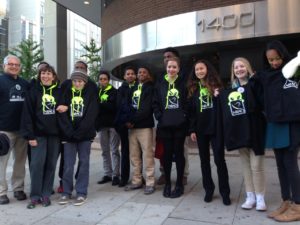ASTRO ACCEL brings together researchers and practitioners in the domains of astronomy education, engagement, communication and culture to connect stakeholders and advance these areas of research, proudly unveils its inaugural cohort of eight early career researchers.
Recent News
NSF Funds New Opportunity for Undergraduate Students
AUI and UNC-Chapel Hill are currently seeking undergraduate students to contribute to cutting-edge research in astronomy education. This paid opportunity, open to education and STEM majors, explores the impacts of new curriculum centered on the use of robotic telescopes.
Stellar Explosions and Cosmic Chemistry
Astronomers have discovered the secrets of a starburst galaxy producing new stars at a rate much faster than our Milk Way. This research revealed many different molecules, more than ever seen before in a galaxy like this.
White House Star Party
AUI and NRAO Attend the White House Astronomy Night
The evening of October 19 brought telescopes, astronomers, astronauts, astronomy educators, and more than 200 students to the South Lawn of the White House for a stargazing event with the President. Among those invited to attend were AUI’s STEM Education Development Officer, Tim Spuck, NRAO-Green Bank’s Education Officer, Sue Ann Heatherly, and one of NRAO’s newest hires, Sabrina Stierwalt. Also in attendance were eleven student representatives from the 2015 Physicists Inspiring the Next Generation: Exploring the Cosmos with NRAO (PING) program including current 9th graders Julia Adler from Culver City, California; Caroline Kragh from Bel Air, Maryland; Ava Patino from New York City; Shira Nash from Washington, D.C.; David Allen from Baltimore, Maryland; Mikiyas Solomon from Laurel, Maryland; Hunter Farrow from Gwynn Oak, Maryland; Izzy Workman from Hendersonville, North Carolina; Justin Price from Randallstown, Maryland; and Kevin Little who is currently an undergraduate student at George Mason University.
In the weeks leading up to Astronomy Night Spuck and Heatherly assisted the National Science Foundation and the White House Office of Science and Technology Policy in planning for this special event. The goal of the White House Astronomy Night was to inspire the next generation of explorers through astronomy and space related science and engineering. President Obama stated in his opening remarks, “When I look out at the faces of these young people I am absolutely confident that there are new frontiers that we’re going to be busting through, in my lifetime and beyond. So thank you for that. You make me excited and you make me inspired.” Just prior to the event, a small group of individuals representing various STEM education initiatives were invited to meet with President Obama. One of the programs recognized was PING: Exploring the Cosmos with NRAO. PING student, Ava Patino, and Paul Gueye, President of the National Society of Black Physicists, had the opportunity to share a few words with the President during this time.

Sofy Alvarez-Bareiro, a high school senior from Brooklyn, New York, explains how craters are formed on the Moon to President Obama
Among the displays AUI and NRAO featured at the event were three optical telescopes, secured through AUI’s network of STEM educators from the Oil Region Astronomical Society and Clarion University’s Science in Motion Project, and the Itty Bitty Radio Telescope. For the first time ever a radio telescope from NRAO made it to the White House lawn!
For more information please contact AUI’s STEM Education Development Officer, Tim Spuck, at [email protected].
Recent News
ASTRO ACCEL Announces Inaugural Cohort of Early Career Researchers
ASTRO ACCEL brings together researchers and practitioners in the domains of astronomy education, engagement, communication and culture to connect stakeholders and advance these areas of research, proudly unveils its inaugural cohort of eight early career researchers.
NSF Funds New Opportunity for Undergraduate Students
AUI and UNC-Chapel Hill are currently seeking undergraduate students to contribute to cutting-edge research in astronomy education. This paid opportunity, open to education and STEM majors, explores the impacts of new curriculum centered on the use of robotic telescopes.
Stellar Explosions and Cosmic Chemistry
Astronomers have discovered the secrets of a starburst galaxy producing new stars at a rate much faster than our Milk Way. This research revealed many different molecules, more than ever seen before in a galaxy like this.

